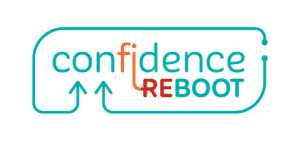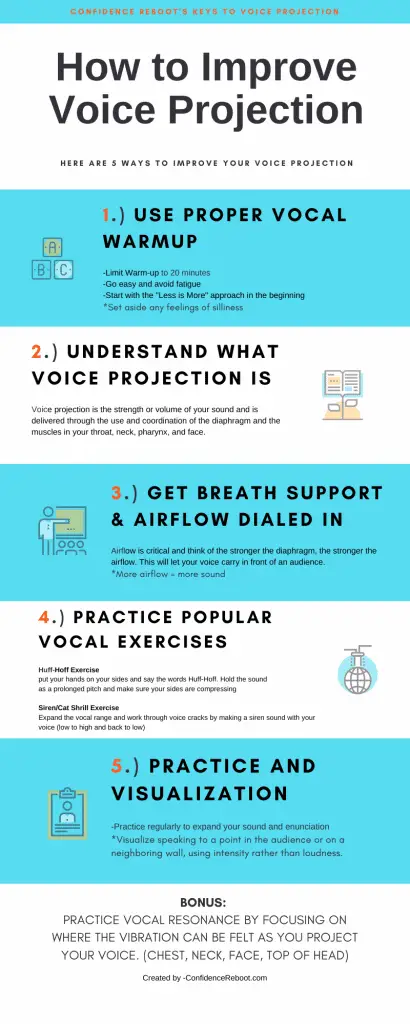Ever wondered, how can I have more control over my voice and train it to carry in a room or in front of an audience?
By the end of this article, you should have a solid understanding of how to get the most out of your voice. You will also find some projection exercises that should help you get ready for your next conversation in a loud noisy environment or when you have a conversation with a group.
Here is the quick version:
Improve Voice Projection for Major Speaking Engagements and Strengthen Vocal Endurance:
- Proper Vocal Warmup (i.e. five-minute humming routine)
- Understand factors that inhibit proper voice projection
- Practice Breathing, Airflow Techniques
- Repetitive Practice & Repetition
- Point Visualization
So how do you improve your vocal projection? Repeat the following process to ameliorate voice projection. Utilize a proper vocal warmup, i.e. five-minute humming routine; understand factors that inhibit proper voice projection; practice proper breathing techniques through repetition, and focus vocal projection to a point when speaking.
Table of Contents
The Vocal Warmup for Proper Projection
First, there are ways to warm up your voice and the best way to warm up your voice in various situations. Think about your voice as a group of muscles that work together to make projection possible. If you were going to perform as an athlete, you would spend the necessary time getting warmed up for a competition, right? Vocally, it’s no different.
While we may think of performers and speakers as two distinct groups, the prep work to improve the projection for singers and speakers is quite similar. Many people don’t think about the effect on your voice a lack of proper technique can have or leave on your vocal cords, so, we will discuss how to get the most out of your vocal cords without overly stressing them.
Here is a good YouTube video on warming up your voice. You can do this in the car on the way to your next debut. But be careful, too much warm-up can also fatigue the voice.
You will want to spend no more than about 20 minutes on this. While you might feel silly, stick with it and practice good breath support.
If you are warming up for public speaking try to do about 5-10 minutes.
When it comes to public speaking, it’s all about the voice.
… and proper projection is a powerful skill.
What is Voice Projection?
For the nerds in the group, like myself, here is a simple definition of voice projection. Voice projection is the strength or volume of your sound and is delivered through the use and coordination of the diaphragm and the muscles in your throat, neck, pharynx, and face.
Think of it as a rock being thrown into calm water. The size of the ripples is the projection. As you can imagine, the bigger the rock, the bigger the (sound) waves.
The key to projection is using a bigger rock and the only way you are going to do that is by coordinating the muscles of your diaphragm and relaxing the muscles in your neck so that the sound can travel up and out.
When it comes to the quality of your voice and what things are available to your voice to increase the liveliness of your sound, you need to understand airflow and breath control.
Tips for Better Vocal Projection
Using the example above, the amount of airflow coming from the diaphragm is the equivalent of the size. It’s the flow for the voice’s sound waves to be bigger. Airflow is the most basic requirement for a good speaking voice. Without it, you tend to suppress your sound.
If you “sit on your voice” or rely on the muscles around the vocal cords and neck to do the work you will put a strain on your voice. The tightness in your throat and the “push” feeling you get in your neck are the killers of voice projection.
When I studied voice back in college, one of the things I learned was that great singers could sing amazingly whether seated or standing. This took a lot of work, but over time, they were capable of training their breath support in a way that supported their voice no matter what their body’s position was.
Once you’ve dialed in your breath support and your throat and neck muscles are engaged but relaxed, you need to work on connecting enunciation and projection.
I was taught for the best projection, you will want to think of holding a smile (not on your face), but in the back of your mouth.
The problem of projection without enunciation is that while the wave of sound might be big, people won’t understand what you are saying, and enunciation without proper projection can make your sound squeaky and unrefined.
At first, much of the technique I’ll describe can feel awkward, but over time, you won’t have to think about it anymore. It’s like dialing in any other activity that you weren’t good at it the first time you tried.
It’s important to set aside time for practice whether your goal is for a good acting voice, a good voice for a play, a singer’s voice, or being heard by your family at Disney in a crowd.
Whatever you are doing with your voice will be easier once you master projection and clarity. Your voice is as one in a million as your fingerprint and you are the only one that will ever have it the way you do. It’s your job to make the natural vibrance come to life that is uniquely yours.
Over time you’ll master the feeling of effortless projection and will be able to improve the sound of your voice.
As you practice, you will want to play with different voices you can produce and see what ranges and resonance is available to you.
If you are a singer, you will find that the stronger your diaphragm becomes, you will be able to use your voice for louder notes with far less effort. It will really help you explore the capacity of your voice.
Voice Projection Exercises
Huff-Hoff Exercise
Remember the story of the wolf and three pigs? -Think of yourself as the wolf.
Take a deep breath and make a loud sound that is like the mixture of Huff and Hoff said at the same time. The idea is that your voice should carry across the room.
Further, imagine that there is a nail in the wall on the other side of the room. Your job (in your mind’s eye) is to drive the nail into the wall with your huff-hoff.
It may be helpful to consider what would you do if you had to drive the nail in by projecting your voice?
Put your hand on your stomach, and make sure that you can feel your stomach muscles compress as you make the sound.
This will help you understand breath control. Over time, you should be able to expand the length of time you hold the same sound at the same intensity.
Use a voice recorder to record your sound so that you get a sense of the difference projecting your voice makes.
Siren/Cat Shrill Exercise – Vocal Expansion
In this exercise, you should try to create a Siren with Your Voice while keeping your neck and throat muscles completely relaxed.
It can be tricky to get an uninterrupted sound as you change the pitch. What you are looking for here is consistency. My vocal coach told me that the sound should flow like melted chocolate rather than rotten milk. Look for consistent density in the sound.
Head Voice and Vocal Resonance Exercises
Practice talking with a high-pitched baby voice. Notice that the sound vibration will be in the top of the head rather than feeling any rumbling or vibration in the chest area or neck area. Understanding where to “place” your voice is essential for proper voice projection and the amount of projection
By placing the resonance, your voice quality will improve dramatically. Again, it is a good idea to use a recorder for this to see what the tone and volume are doing as you play with the different resonance registers.
Get used to your sound even though it can be difficult to hear your own speaking voice. Pay close attention during your projection exercises for tension, strain, tone, loudness, and resonance.
It should feel nearly effortless to produce a good amount of volume, and over time, you will find the low resonance you are looking for or the perfect blend between your breathy voice and your full voice that you are looking for.
A great read for further information is a book that I read years ago. I highly recommend it if you are looking for ways to “find” and develop your best voice. Winning with Your Voice – Dec. 31, 1996 by Morton Cooper

